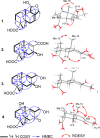Neurite Outgrowth-Inducing Drimane-Type Sesquiterpenoids Isolated from Cultures of the Polypore Abundisporus violaceus MUCL 56355
- PMID: 37910033
- PMCID: PMC10683085
- DOI: 10.1021/acs.jnatprod.3c00525
Neurite Outgrowth-Inducing Drimane-Type Sesquiterpenoids Isolated from Cultures of the Polypore Abundisporus violaceus MUCL 56355
Abstract
Abundisporin A (1), together with seven previously undescribed drimane sesquiterpenes named abundisporins B-H (2-8), were isolated from a polypore, Abundisporus violaceus MUCL 56355 (Polyporaceae), collected in Kenya. Chemical structures of the isolated compounds were elucidated based on exhaustive 1D and 2D NMR spectroscopic measurements and supported by HRESIMS data. The absolute configurations of the isolated compounds were determined by using Mosher's method for 1-4 and TDDFT-ECD calculations for 4 and 5-8. None of the isolated compounds exhibited significant activities in either antimicrobial or cytotoxicity assays. Notably, all of the tested compounds demonstrated neurotrophic effects, with 1 and 6 significantly increasing outgrowth of neurites when treated with 5 ng/mL NGF.
Conflict of interest statement
The authors declare no competing financial interest.
Figures










References
-
- Hyde K. D.; Xu J.; Rapior S.; Jeewon R.; Lumyong S.; Niego A. G. T.; Abeywickrama P. D.; Aluthmuhandiram J. V. S.; Brahamanage R. S.; Brooks S.; Chaiyasen A.; Chethana K. W. T.; Chomnunti P.; Chepkirui C.; Chuankid B.; de Silva N. I.; Doilom M.; Faulds C.; Gentekaki E.; Gopalan V.; Kakumyan P.; Harishchandra D.; Hemachandran H.; Hongsanan S.; Karunarathna A.; Karunarathna S. C.; Khan S.; Kumla J.; Jayawardena R. S.; Liu J. K.; Liu N.; Luangharn T.; Macabeo A. P. G.; Marasinghe D. S.; Meeks D.; Mortimer P. E.; Mueller P.; Nadir S.; Nataraja K. N.; Nontachaiyapoom S.; O’Brien M.; Penkhrue W.; Phukhamsakda C.; Ramanan U. S.; Rathnayaka A. R.; Sadaba R. B.; Sandargo B.; Samarakoon B. C.; Tennakoon D. S.; Siva R.; Sriprom W.; Suryanarayanan T. S.; Sujarit K.; Suwannarach N.; Suwunwong T.; Thongbai B.; Thongklang N.; Wei D.; Wijesinghe S. N.; Winiski J.; Yan J.; Yasanthika E.; Stadler M. Fungal Divers. 2019, 97, 1–136. 10.1007/s13225-019-00430-9. - DOI
Publication types
MeSH terms
Substances
Supplementary concepts
LinkOut - more resources
Full Text Sources
Molecular Biology Databases

